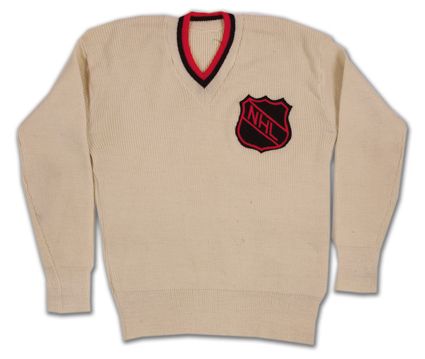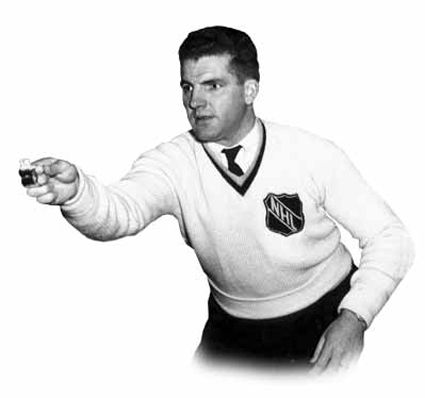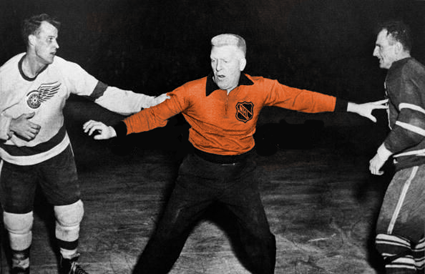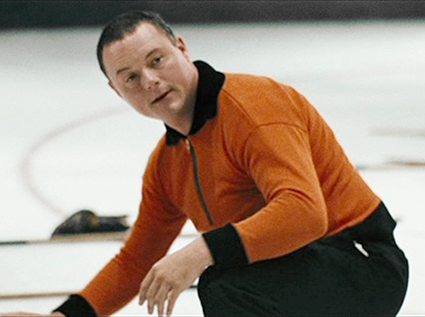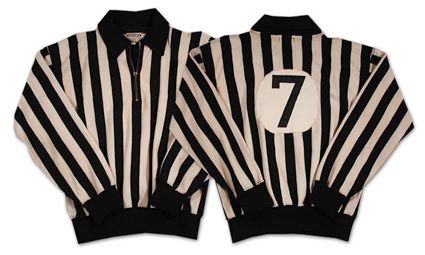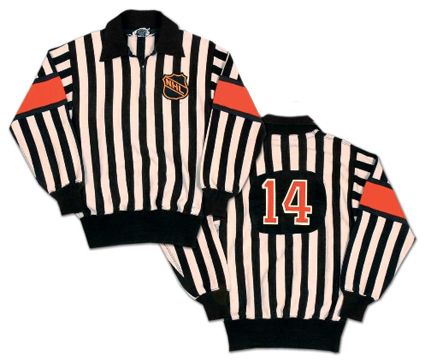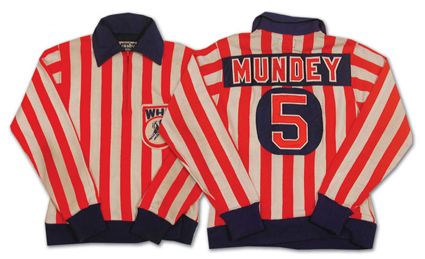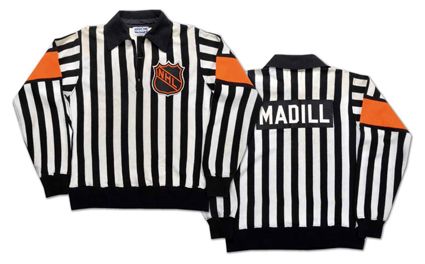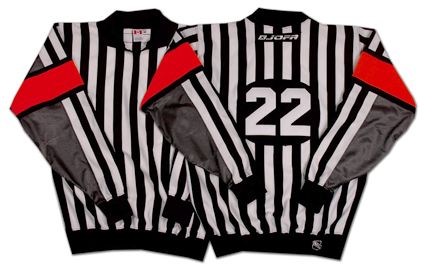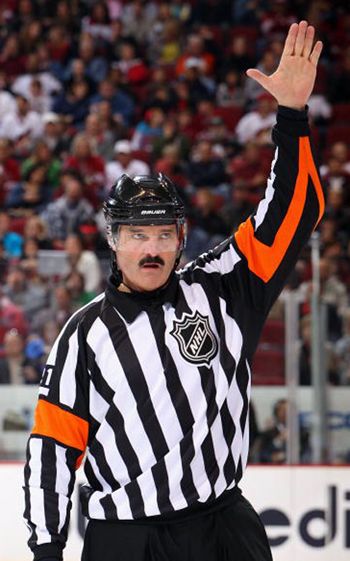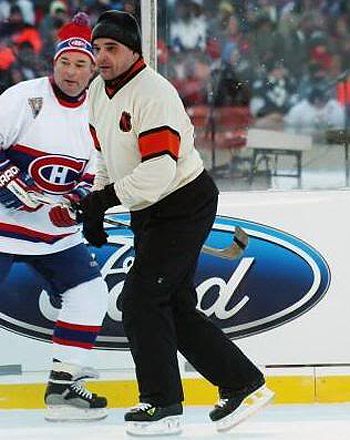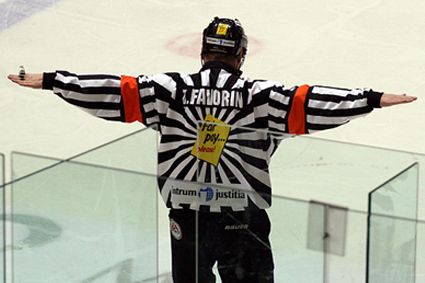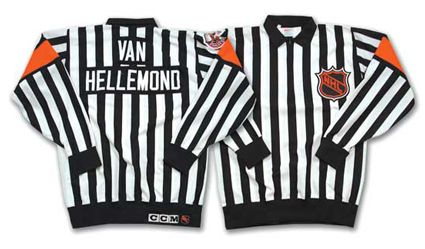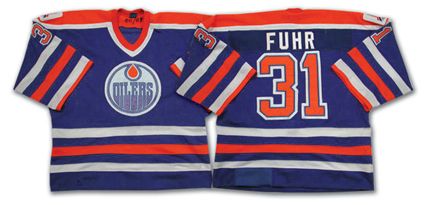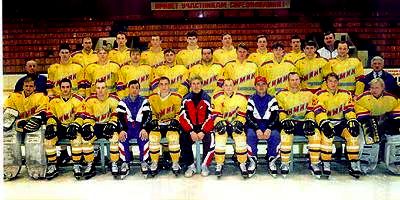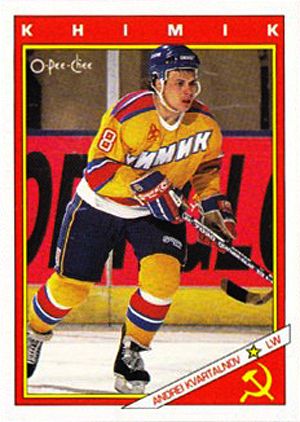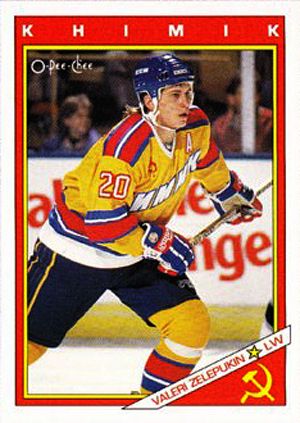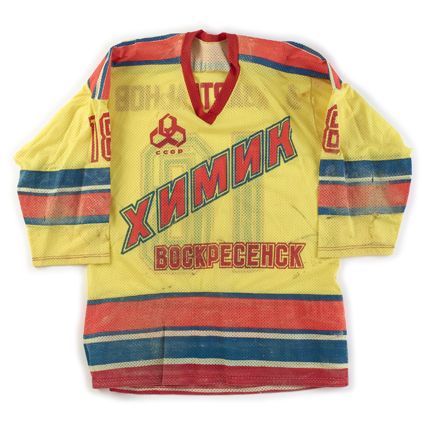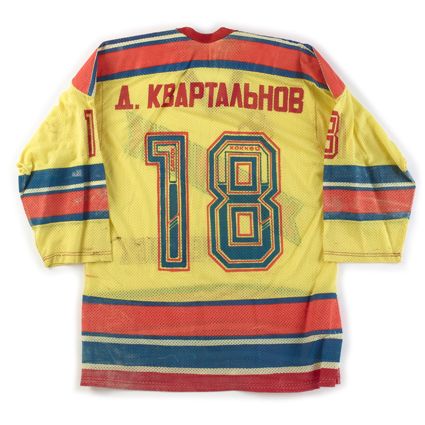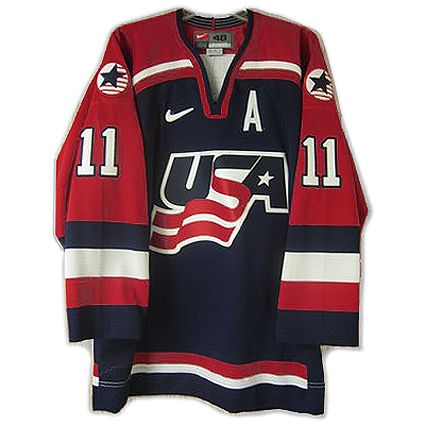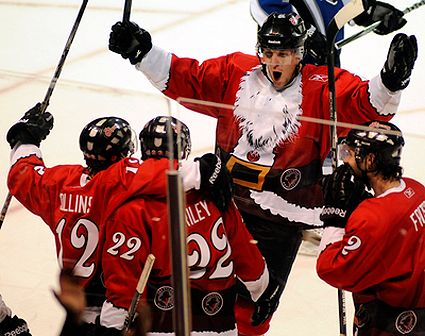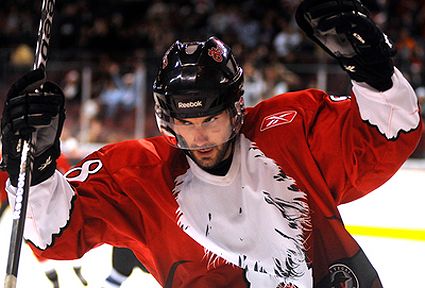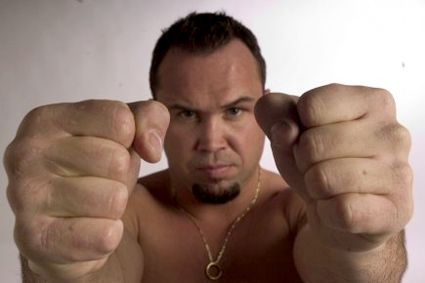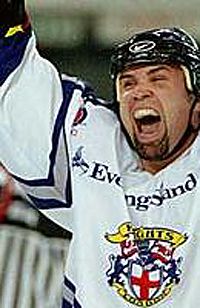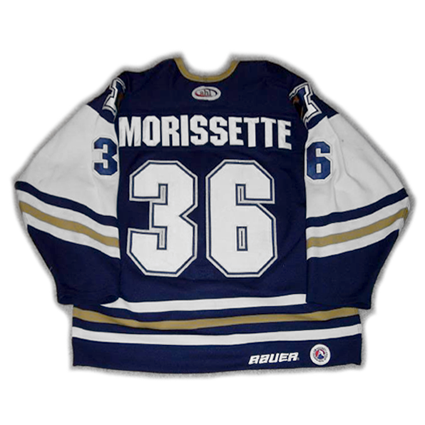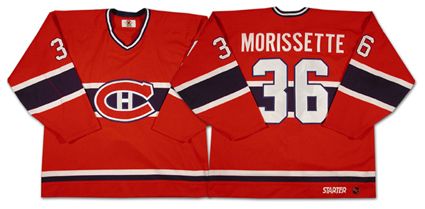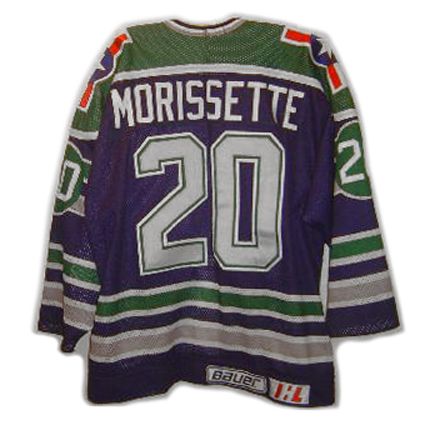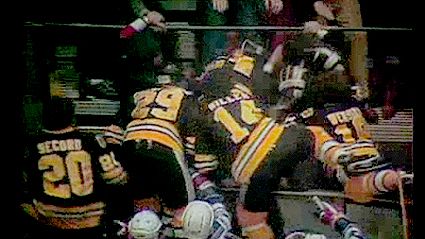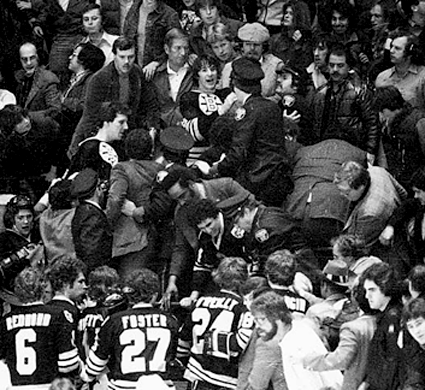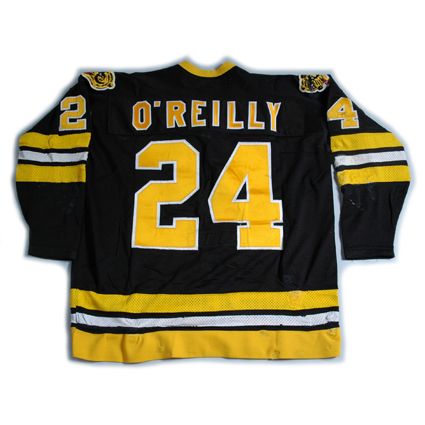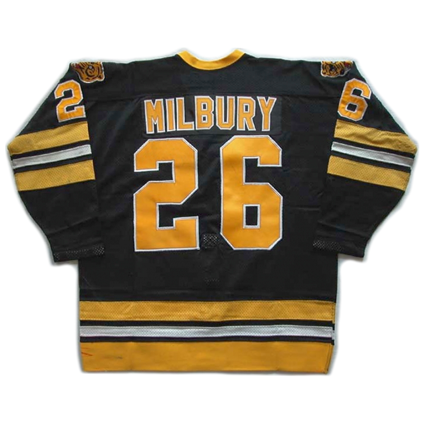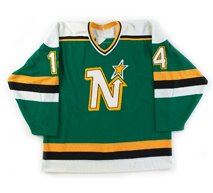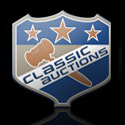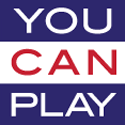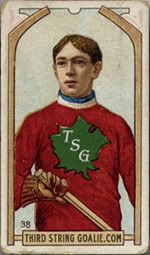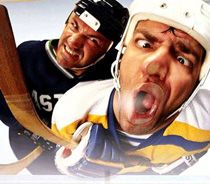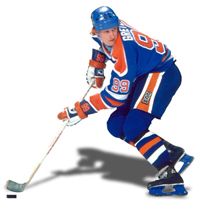Gordie Howe and Ted Kennedy in the early 1950's
Wednesday, December 29, 2010
1992-93 NHL Referee Andy Van Hellemond Jersey
Prior to wearing the familiar black and white striped jerseys, NHL referees wore cream colored sweaters, as well as neckties, which made for a quite dapper look. The cream sweaters lasted into the early 1950's.
1940's NHL referee's sweater
Hockey Hall of Famer and first American referee Bill Chadwick wearing a cream colored referees sweater, complete with necktie
Following the cream colored sweaters, in order to differentiate themselves from the home player's white sweaters, NHL referees changed in March of 1953 to a bright orange style with a half zip front, which sadly meant neckties were no longer worn.
Referee Red Dunn tries to maintain order between
Gordie Howe and Ted Kennedy in the early 1950's
Gordie Howe and Ted Kennedy in the early 1950's
An orange referee's sweater from the 2005 film "The Rocket: The Legend of Maurice Richard"
Finally on this date in 1955, NHL on-ice officials wore brand new vertically striped black and white sweaters for the first time ever during a game between the Montreal Canadiens and the Toronto Maple Leafs, which was won by Montreal 5-2.
1950's NHL referee's sweater
At some point the referees began wearing orange arm bands to differentiate themselves from the linesmen, and today's NHL sweaters have remained essentially unchanged since then.
1960's NHL referee's sweater, now displaying orange armbands
While the NHL referees' sweaters had now reached what would essentially be their final look, the World Hockey Association, which arrived on the scene in 1972, did so with a splash, outfitting their officials in bold, if not gaudy, red and white striped sweaters, which featured not only the officials number on the back, but their name as well.
1970's WHA referee's sweater
Sometime around 1977, NHL referees began to wear their names on their backs instead of the traditional numbers.
1980's NHL referee's sweater with the referee's name on the back rather than the traditional numbers
The use of names on the back lasted until a return to the use of numbers once again for the 1994-95 season. NHL rules stipulate that referees have to wear numbers between 2 and 49, while linsemen can choose numbers from 50 to 98, with #1 and #99 not being permitted.
2000's NHL referee's sweater
There has been some tinkering of the referee's sweaters as of late, with black undersides to the sleeves, as well as an ill-fated attempt to change the orange armbands to silver for the 2007-08 season in an attempt to tie in with the new silver and black colors of the new NHL shield. With the silver armbands proving essentially invisible, this idea thankfully died a quick and quiet death.
See if you can spot the silver referee's arm stripes
The latest tweak to the sweaters arrived at the 2009 NHL All-Star Game, when new fabrics and additional black trim were added to the sweaters, as well as extending the orange arm bands down the length of the bottom of the arms, which are visible when the referee's arm is fully raised. These sweaters were adopted full time and have been in use starting with the 2009-10 season.
2009 NHL referee's sweater
At times officials have worn patches on their jerseys, such as the league-wide patches for the Stanley Cup Centennial, as is the case with today's featured jersey. There have also been instances of referees wearing memorial patches as well. In the 1989-90 season, officials wore the initials "J. McC." on their sweaters to memorialize John McCauley, the director of NHL officiating who passed away in June 1989. In 2005-06 NHL officials wore a #72 patch in memory of linseman Stephane Provost who passed away in May 2005 due to a motorcycle accident.
Another notable referee's jersey was worn during the 2000 NHL All-Star Game in Toronto, when the teams wore futuristic jerseys inspired by the millennium, which carried over to the referee's jerseys. They featured a vertical orange stripe down the left side of the jersey, both front and back, with the 2000 All-Star Game patch centered over the stripe on the right chest.
The cream colored sweaters were revived during the 1991-92 NHL season whenever two of the Original 6 teams played against each other while wearing their Turn Back the Clock jerseys, as well as that season's NHL All-Star Game, when both teams wore throwback jerseys in recognition of the NHL's 75th anniversary.
Ray Scampinello wearing a 1991-92 NHL throwback referee sweater
The cream throwback sweaters were also put back into service during the first NHL outdoor event, 2003's Heritage Classic when the Montreal Canadiens legends took on a team of Edmonton Oilers legends, with both teams wearing throwback jerseys and the officials once more got into the spirit of the event with turn back the clock sweaters of their own.
2003 Heritage Classic referee Andy Van Hellemond
The next outing for the cream colored throwbacks was an appearance at the 2004 NHL All-Star Game in St. Paul, Minnesota when the referee's joined in with the players throwback jersey look, only this time with the All-Star Game patch on the upper right chest but without the need for the toques!
Unlike the clean look of referee's sweaters in the NHL, the referee's sweaters in european hockey are viewed as prime real estate for advertisements, such as the sponsorship worn by referee's at the IIHF World Championships in the 2000's.
Referee at the IIHF World Championships with sponsorship on his sweater
Not even the traditional vertical stripes of the referee's sweaters are considered sacred in european leagues!
European league referee with an unorthodox striping pattern
Today's featured jersey is a 1992-93 NHL referee Andy Van Hellemond sweater. This sweater was worn during the era of referees wearing their names on the backs of their sweaters. This jersey also features the Stanley Cup Centennial patch as worn on not only all the players jerseys in 1992-93, but also the referees' sweaters.
Van Hellemond began officiating NHL games in 1969 and continued to do so until his retirement in 1996, a span of 28 years, which included 19 Stanley Cup Finals. He became the first on-ice official to wear a helmet in 1984, something which became mandatory in 2006-07.
Van Hellemond was the director of NHL officiating from 2000 to 2004 and was inducted into the Hockey Hall of Fame in 1999.
Our video section today pays tribute to referee's and linsemen and the risky job it can be on the ice with the array of sticks, pucks, skates and even fists they must try to avoid, sometimes unsuccessfully.
Several NHL referees and linesmen have written books about their careers from their unique point of view. To purchase one of them, please click on the links below.
Labels:
Referee's Jerseys
Tuesday, December 28, 2010
1988-89 Edmonton Oilers Grant Fuhr Jersey
On this date in 1918, Georges Vezina of the Montreal Canadiens became the first goalie in NHL history to be awarded an assist when Newsy Lalonde gathered up the puck after a save by Vezina, skated the length of the ice and scored a goal during a 6-3 Canadiens win over the Toronto Arenas.
Georges Vezina
It would take 61 years before a goaltender would be credited with scoring a goal, and he never actually shot the puck. That occurred on November 28, 1979 when Rob Ramage of the hapless Colorado Rockies gathered up the puck after a save by the New York Islanders Billy Smith during a delayed penalty call and passed the puck back out of the corner, which unfortunately for the Rockies sailed by his intended teammates and had enough force to continue all the way down the length of the ice and into the Rockies unmanned goal.
It would take eight more years for an NHL goalie to genuinely shoot the puck into the opposing net when Ron Hextall of the Philadelphia Flyers score against the Boston Bruins on December 8, 1987. Hextall later scored again during the playoffs against the Washington Capitals on April 11, 1989.
Martin Brodeur of the New Jersey Devils is the only other goalie to date to have scored twice with a playoff goal in 1997 and a regular season goal in 2000.
Jeff Reese holds the record for most points by a goaltender in a game with three, which he scored on February 10, 1983 while playing for the Calgary Flames.
It should come as little surprise to find out that an Edmonton Oiler holds the record for most points by a goaltender in a season, as well as the career record for most points by a goalie. Those honors belong to Grant Fuhr of the high powered Oilers. His record of 14 points in 1983-84 set the standard which still remains the one to beat more than 25 years later.
While Fuhr certainly earned a number of assists by simply going behind the net and teeing up a dump-in for Paul Coffey to carry up the ice and set up a Wayne Gretzky goal, Fuhr also earned a number of assists by firing the puck up the ice to an open teammate to initiate a rush.
Fuhr career total of 60 points (which includes regular season and playoffs combined) leads all goalies in career scoring, followed by Patrick Roy's 56, who just barely tops the 55 scored by Tom Barasso. Brodeur ranks fourth all time with 44 points, two of which were goals. Mike Vernon's 41 leads both Hextall and John Vanbiesbrouck at 38, with two of Hextall's points coming from his goals.
The rest of the top ten consist of Ed Belfour at 35, Curtis Joseph's 33 and the tenth spot is occupied by both Sean Burke and Dan Bouchard, who are tied at 30. Honorable mention goes to Kirk McLean (29), Andy Moog (28), Bill Ranford (26) and the duo of Mike Palmateer and Tony Esposito with 25 each. Of the 16 goalies listed, only Broduer remains active.
Today's featured jersey is a 1988-89 Edmonton Oilers Grant Fuhr jersey. Fuhr remains the all-time point scoring leader among NHL goalies with 60, four more than the next closest pursuer, and holder of the most points in a season by a goaltender for over 25 years.
Fuhr played 19 NHL seasons and won 403 games with the Oilers, Buffalo Sabres, Toronto Maple Leafs, Los Angeles Kings, St. Louis Blues and Calgary Flames as well as being the Oilers starting goaltender for Stanley Cup championships with the Oilers in 1984, 1985, 1987 and 1988. He also won the Canada Cup in both 1984 and 1987. He also won the Vezina Trophy in 1988 and was inducted into the Hockey Hall of Fame in 2003. Just to be clear, the Vezina Trophy is awarded for puck stopping ability, not goalie scoring exploits!
Here is footage of Broduer's first goal, which came in the 1997 playoffs.
Our final video today is a tribute to Grant Fuhr and a collection of some of his flashiest saves.
Dasherboard: The World Junior Championships had a light schedule yesterday. Slovakia won in 2-1 overtime in their game against the plucky Germans to pull even with the United States with two points in the Group A standings, one point behind Switzerland.
In Group B, the Czech Republic did what was require by shutting out Norway, but the 2-0 score does little to inspire anyone into believing the Czechs will be strong enough to advance to the Playoff Round in light of Sweden's 7-1 drubbing of Norway the day before.
Today's schedule is a full four games, with Switzerland and Finland battling it out in Group A. With three points for a win in international hockey, a win for Switzerland would all but guarantee them a place in the Playoff Round. The day's second game has the Czech Republic hoping to stifle Canada's scoring attack and come away with at least a point or two in the standings. A win for Canada, even if it comes in overtime, will put them in an excellent position to advance with Norway still on their schedule and a likely three points from that game.
Sweden will be facing Russia at Dwyer Arena in the best matchup the smaller rink will see all tournament. A regulation win for Sweden will certainly put the Russians in a bad spot while a win for the Russians keeps them right in the mix in the "Group of Death".
The final game of the day has the United States looking to improve upon their performance in their opening game which went to overtime. A regulation win could very well see them at the top of the group by the end of the day and in a good position to earn one of the coveted byes directly into the semifinals.
Labels:
Edmonton Oilers,
Fuhr Grant,
Vezina Georges
Monday, December 27, 2010
1989-90 Khimik Voskresenek Dimitri Kvartalnov Jersey
The hockey club Khimik Voskresensk was formed in Voskresensk 55 miles southeast of Moscow in the Soviet Union and played their first game on this date in 1953, with "Khimik" meaning "Chemists" in deference to the local chemical plant which sponsored the club.
It took the club just three years to rise to the top level of Soviet ice hockey. They won bronze medals in the Soviet League playoffs in 1965 and 1970. Starting in the mid-1980's the club entered the period of it's greatest success with a third bronze medal in 1984 prior to achieving their best ever result of a silver in 1989, which they immediately followed with another bronze in 1990.
Also in 1990, Khimik Voskresensk was chosen as one of four clubs to compete in the Super Series, a schedule of exhibition games against NHL teams played in North America, a fine reward for their recent run of good play. Khimik fared fairly well, beating Los Angeles 6-3, lost to Edmonton and Calgary 6-2 and 6-3, rebounded to down Detroit 4-2 but then lost to Washington 5-2. They concluded their trip with a 6-3 win over St. Louis to finish with a 3-3 record.
Khimik Voskresensk
They returned in 1991 with very similar results, losing to Los Angeles 5-1 and St. Louis 4-2 before a tie with the New York Islanders 2-2. They then strung together three consecutive wins over Montreal 6-3, Buffalo 5-4 and Boston 5-2 before a loss to Minnesota 6-4 once more left them with a .500 record at 3-3-1.
Changes in the way the club was run on the business side began to occur in the late 1990's due to the collapse of the Soviet Union, which led to the club losing it's sponsorship when the chemical plant found a new owner, as well as the departure of it's better players to not only the NHL, but the leagues in Germany, Finland and Sweden. Eventually the club first altered it's name from Khimik Voskresensk to Khimik Moscow Oblast, with "Oblast" being the equivalent to a province, in an effort to represent the entire region around Moscow, which was quite an ambitious claim seeing how the Moscow Oblast was already home to Central Red Army, Dynamo, Spartak, Wings and Lokomotiv at the time.
In 2005 the club relocated to Mytishchi, 60 miles northwest of Voskresensk and changed their name to Atlant Moscow Oblast in 2008 in time for the formation of the Kontinental Hockey League, bringing to an end the club's use of the Khimik name for good after 46 seasons of play.
Following the team's relocation away from Voskresensk, a new expansion team called HC Khimik Voskresensk was formed, but has no connection to the original club and it's history.
During their history, Khimik produced many recognizable names, particularly in more recent times as they players came over to North America to compete in the NHL. Dimitri Kvartalnov won the Soviet League scoring title while playing for Khimik in 1990 prior to playing for the Boston Bruins.
Dimitri Kvartalnov, incorrectly identified as his brother Andrei
Germain Titov played 624 NHL games primarily with the Calgary Flames, Slava Kozlov played 1,182 games in the NHL and won two Stanley Cups with the Detroit Red Wings, Sergei Berezin logged more than 500 games, first with the Toronto Maple Leafs, Andrei Lomakin was one of the early Soviet players to make the move to North America, while Valeri Zelepukin and Sergei Brylin both won the Stanley Cup with the New Jersey Devils in 1995.
Valeri Zelepukin
Current Montreal Canadien Andrei Markov began his professional career with Khimik, as did Stanley Cup winner Valeri Kamensky, but the best known player to have come out of the Khimik must be Igor Larionov, who led Khimik in scoring in 1981 and eventually went on to win two gold medals in the Olympics, four in the World Championships, one in the Canada Cup and three Stanley Cups with the Red Wings.
Today's featured jersey is a 1989-90 Khimik Voskresenek Dimitry Kvartalnov jersey as worn by Kvartalnov when he was the leading scorer in the Soviet League. It's typical of the Soviet jerseys of the era in that it is a relatively light weight mesh and all the graphic elements are either dye sublimated or screened on. Of note are the wild numbers on the back. This jersey also has Dimitri's first initial "D" on the back in cyrillic, as his brother Andrei was also a member of the team.
Dasherboard: In the 2011 World Juniors, Switzerland roared out to a 4-0 lead by the end of the first period only to have the determined Germans get back to within one with 4:41 to play, but Switzerland held on to take the three points in Group A.
Also in Group A, the United States got the win in overtime on a goal by Nick Bjugstad. The win in overtime was worth two points, with Finland earning one.
In Group B, Canada scored three third period goals to pull away from Russia, who played Canada even through the first two periods before falling 6-3. In the other group game, Sweden trounced Norway 7-1.
Labels:
Khimik Voskresenek,
Kvartalnov Dimitri
Sunday, December 26, 2010
2004 Team USA Zach Parise Jersey
Today kicks off the IIHF 2011 World Junior Hockey Championships in Buffalo, New York where the 2010 champions from the United States will be looking to defend their title on home ice.
The World Juniors have become a much anticipated annual event, particularly in Canada, and anybody who's anybody has played in the tournament on their road to the NHL, dating back to Wayne Gretzky, Jari Kurri, Mario Lemeiux, Steve Yzerman, Alexander Mogilny, Sergei Fedorov, Jeremy Roenick, Mike Modano, Pavel Bure, Jaromir Jagr and Peter Forsberg through current NHL stars Jarome Iginla, Daniel and Henrik Sedin, Zach Parise, Ryan Getzlaf, Alexander Oveckin, Evgeni Malkin, Sidney Crosby, Johnathan Toews and Patrick Kane, making it a must-see event each year.
The ten teams in this year's edition are divided into two groups of five and each team will play the other four teams in it's group once each in the Preliminary Round, with the top three advancing to the Playoff Round. With so few games determining each team's fate, no one can afford to take a night off as each and every game is critical to each team's chances.
For the unfortunate four clubs who finish in the bottom two of their groups, they will be placed in the Relegation Round. Following a round-robin schedule among the four, the bottom two teams of the group will be demoted to the Division I level for 2012 and will need to earn their way back up to the Top Division, which can only be achieved by winning a championship in Division I. Second place earns you nothing but another season at the Division I level. This relegation format ensures that nearly every game matters in the World Juniors and the games that determine which clubs stay up can be very exciting affairs when two countries are battling with survival on the line. We strongly encourage those in attendance take in the final day of the relegation round if the placings have not already been determined at that point. Spirited games in the much more homey secondary arena can provide some terrific competition in a small town or collegiate atmosphere that differs greatly from the environment more polished main rink and is a recommended part of the World Junior Tournament experience.
Once in the Playoff Round, the two group winners will receive a bye directly into the semifinals as a reward, while the second place team in Group A will face the third place team in Group B and vice-versa, with those two quarterfinal games taking place on January 2nd.
The two quarterfinal winners advance to face the group winners, who will enjoy the advantage of two days of rest, in the semi finals on January 3rd. The semifinal losers will meet for the bronze medal on January 5th with the winners meeting for the gold medal later that evening.
Thanks to some unexpected results in recent tournaments, the usual even distribution of familiar hockey powers in each group has been thrown out the window for 2011. Group A consists of the United States, Switzerland, who finished a strong fourth in 2010, Finland, Slovakia and recently promoted Germany.
Group B on the other hand, has been declared "The Group of Death" and is stacked with Canada, Sweden, Russia, who were classified a disappointing 6th in 2010, the Czech Republic, who shockingly found themselves in the Relegation Round in 2010, and underdogs Norway.
In Group A, the Americans are favored to advance and will be looking to earn one of the coveted byes into the semifinals. Finland and Switzerland are also expected to advance to the Playoff Round and must avoid giving away points, or worse, being upset by either Slovakia or Germany. The Slovaks goal will be to avoid the relegation round, and to do so, must upset one of the favored three teams and steal a point by getting to overtime against one of the other two.
Germany's goal for 2011 will be to maintain their place in the Top Division by surviving the Relegation Round. Their game against Slovakia on December 27th will be a key opportunity to gain points towards that end should Slovakia be the other team placed in the Relegation Round, as the game between the two teams from each group that are placed in the Relegation Round will carry over to the Relegation Round standings.
Group B is obviously a lot more complicated, as annual championship contenders Canada, Sweden, who have strongly re-emerged from a down period with three consecutive medal placings, Russia, who will not want a repeat of last year's disappointing placing following five consecutive finishes in the medals, and the Czech Republic, will all slug it out for the bye awarded to the group winner, with one of those four guaranteed a place in the fight to avoid relegation.
Poor Norway will be in for a rough go and will most certainly be hoping one of the four teams ranked above them will be having a down year and that they can take some points out of the game against the club that will join them in the relegation round for a shot at unlikely survival.
Canada put together a dominant run of five consecutive titles from 2005 to 2009, but their program is a victim of it's own success in breeding top quality players, as tournament eligible players Matt Duchene and Ryan O'Reilly (Colorado), Tyler Seguin (Boston), Jeff Skinner (Carolina), Evander Kane (Atlanta), Taylor Hall (Edmonton) and Kyle Clifford (Los Angeles) will not take part due to having found gainful employment in the NHL. Still, 16 of the 22 Canadian players are already first round draft picks in the NHL. Once again, similar to 2005 when the United States hosted the tournament in Grand Forks, North Dakota, the proximity of the tournament to Canada, this time less than four miles from the Canadian border, should ensure the Canadians will feel right at home playing in front of tens of thousands of red-clad supporters waving the Maple Leaf each time they take to the ice.
The host United States has eight players returning from the team that won gold in overtime to break Canada's streak last year. Goaltender Jack Campbell, defenseman John Ramage and forwards Ryan Bourque, Jerry D'Amigo, Chris Kreider, Jeremy Morin, Kyle Palmieri and Jason Zucker all are back in an attempt to capture a second consecutive gold, this time on home ice.
The tournament begins with four games today, with Germany taking on Switzerland in the opening game at 12:30 PM (all times eastern) in the first of three games at the 18,000 seat HSBC Arena in Buffalo.
The NHL Network in the United States will be replaying last year's gold medal game between the United States and Canada at 2 PM (following replays of the USA's 2010 quarterfinal and semifinal games) as a prelude to their airing of the all-important second game on the schedule between Canada and Russia at 4 PM, also in Buffalo. The game will be carried in Canada by TSN.
Also starting at 4 PM, Norway opens against Sweden at the 2,100 seat Dwyer Arena on the Niagara University campus and the day is capped off by the United States beginning it's championship defense with a stiff challenge from Finland, which will be televised by the NHL Network in the US and on TSN2 in Canada at 6 PM.
Fans in attendance in Buffalo will have the luxury of being able to attend any game they choose since the two arenas are located just 16 miles apart, unlike some other years when the two host arenas have been several hours drive between them. With the large number of games compressed into such a small schedule, the second arena can often find itself hosting some terrific matchups, such as Sweden vs. Russia on December 28th and the Czech Republic vs. Russia on December 31st in a more personal atmosphere than the professional sized main rink has to offer. We highly recommend taking in one game at the secondary arena during the Preliminary Round each year when possible.
In the United States, the NHL Network will be airing all four of the Preliminary Round games for both the United States and Canada, as well as the game on Thursday between Sweden and the Czech Republic at 3 PM. With each game for the US and Canada of the preliminary round being aired, it means each team in the tournament will be on TV at least once.
Once the Playoff Round begins, all six games on January 2nd, 3rd and 5th will be aired through the gold medal final.
For viewers in Canada, the four Canadian Preliminary Round games, as well as the US vs. Finland on December 26th (8 PM - TSN 2), Sweden vs. Russia on December 28th (7 PM), both Sweden vs. the Czech Republic (3 PM) and Germany vs. the United States (7 PM) on December 30th and the United States vs. Switzerland on December 31st (8 PM) will be aired prior to their coverage of the six Playoff Round contests.
In a nice bit of traditional scheduling, the tournament always takes off New Year's Day between the Preliminary Round and the commencement of the playoffs, avoiding any conflict with the now annual NHL Winter Classic, which just also happens to take place less than four hours drive down the freeway in Pittsburgh for the more ambitious (and financially well off) ones in attendance in Buffalo.
Today's featured jersey is a 2004 United States National Team Zach Parise jersey from the first American team to ever capture a gold medal at the World Junior Tournament, which took place in Helsinki, Finland. The United States won their group by defeating Austria, Slovakia, Sweden and Russia before defeating Finland and then Canada in the final to claim the championship.
Parise led the US with five goals and 11 points on his way to being named the Most Valuable Player of the tournament.
This style of jersey was first used by the United States at the 2002 Olympics in Salt Lake City and remained in use through the 2005 World Junior Tournament.
Here are extended highlights from the 2004 World Juniors when the United States captured the gold medal thanks to an errant clearing attempt by Canadian goaltender Marc-Andre Fleury.
This next highlight is the gold medal winning goal in overtime by American John Carlson from last year's World Juniors, the second title for this year's hosts the United States.
Labels:
Parise Zach,
USA,
World Junior Championships
Saturday, December 25, 2010
Merry Hockey Christmas! Joyeux Hockey Noël!
We hope Santa was good to you this year and brought you the jersey you've been wanting!
We also hope you enjoy our special video collection today.
Don't forget - as our countdown clock in the right hand column shows - tomorrow the World Junior tournament begins, the annual festival hockey featuring "Tomorrow's Stars Today"!
And now...
On to the videos!
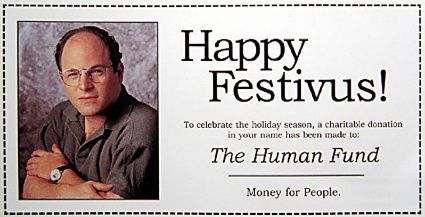
Again, Merry Christmas and Happy Holidays, and for those of you who do not celebrate Christmas, Happy Festivus!

Labels:
humor
2010-11 Las Vegas Wranglers Christmas Jersey
Often minor league teams will create special one-off jerseys to be worn on special occasions and holidays, such as Valentine's Day, Halloween, New Year's Eve and, of course, Christmas.
This year was no exception and the Las Vegas Wranglers of the ECHL have produced one of the most creative, well executed and effective specialty jerseys of all time.
Creative, in the way they incorporated the players head and hands into the design. Well executed, since they look great and effective, in that they made the players appear fat and slow, fooling their opponents on December 18th and 19th, the Idaho Steelheads, into thinking they were going to have an easy time of it, which produced a 4-1 win the first night followed by a 6-3 win on the second night for the Wranglers.
Here are a couple of pictures of today's featured jerseys, the Las Vegas Wranglers 2010-11 Christmas jerseys, in action, followed by some amazing video footage of Kael Mouillierat getting his ass kicked by Santa Claus. One can only hope the children in attendance were not traumatized by the scene of Santa Claus going Chuck Norris or were at least scared straight by the spectacle.
Friday, December 24, 2010
1999-00 Quebec Citadelles Dave Morissette Jersey
Born on this date in 1971, Dave "Moose" Morissette was a bruising left winger who amassed penalty minutes by the hundreds.
Extra bonus jersey: Today's extra bonus jersey is a 1997-98 Houston Aeros Dave Morissette jersey. This jersey is one of the most popular minor league jerseys of all time, and when the club changed to a new modern fighter jet logo, the outcry was so great that that the team restored the classic bomber logo to their jerseys the following season. Like the Citadelles jersey, it also has a sponsorship patch on the right chest.
He played his junior hockey with the Shawnigan Cataractes and his toughness instantly earned earned him the role as one of the team's enforcers, as Morisette finished second on the team in penalty minutes as a rookie with 298, which was good for fifth in the QMJHL in 1989.
The following season he led the team in penalty minutes as he slugged his way to 269 PIMs, placing sixth overall. After seasons of 15 and 11 points, Morissette found his offensive game for the only time of his career when he netted 20 goals and 26 assists in addition to the expected 224 penalty minutes to again lead the team.
Following his final season of junior hockey, Morissette was drafted by the Washington Capitals in the 1991 NHL Entry Draft. He played the 1991-92 season with the Hampton Roads Admirals of the East Coast Hockey League, who went 42-20-0-2 and went on to win the Riley Cup as champions of the ECHL. Morissette of course led the Admirals with 293 penalty minutes, eighth in the league.
He returned to Hampton Roads the following season as the Admirals defended their title to capture their second consecutive ECHL championship. He improved upon is 16 points the previous season with 9 goals and 22 points, which would prove to be career highs as a professional. He would also surpass the 200 penalty minute mark once again with 226.
Morissette played for the ECHL's Roanoke Express in 1993-94, with his team leading 278 PIM's placing him in the top ten in the notoriously rugged ECHL.
For the 1994-95 season, "Moose" moved up to the International Hockey League, appropriately enough with the expansion Minnesota Moose and became an instant fan favorite thanks to his outgoing personality and rough and tumble style. After two seasons and 83 games with the Moose, he moved down south to join the Houston Aeros for two seasons, the second of which, 1997-98, had Morissette once again leading his team in penalty minutes with 254, the third highest of his professional career.
After seven minor league seasons, Morissette was rewarded with his first NHL action after signing as a free agent with the Montreal Canadiens for the 1998-99 season. He would play ten games for Montreal that season and manage to participate in six fights. While in the AHL that season, he saw action in 39 games with the Fredericton Canadiens as well as 12 playoff games.
While in the NHL, Morisette fought several renowned heavyweights,
including the likes of Bob Probert
including the likes of Bob Probert
The Fredericton franchise was relocated and renamed for 1999-00, becoming the Quebec Citadelles, with whom Morissette played 47 games, amassing 231 penalty minutes to lead the Citadelles. He played in a single game for Montreal in the NHL, earning a major penalty for a fight.
His career wound down in 2000-01 with five games with the Lake Charles Ice Pirates of the Western Professional Hockey League and 13 games in England with the London Knights of the British Ice Hockey Super League. In just 13 games with the Knights, Morissette made his presence known with 117 penalty minutes but had his season cut short and his career ended by a concussion which knocked him out for 30 minutes.
Morissette while with the London Knights
His final combined totals were 673 games played, 69 goals and 104 assists for 173 points and 2,943 minutes in penalties, the equivalent of 49 complete games in the box!
Following his career, Morissette wrote a book in 2005 before the NHL even had a drug testing policy, Mémoires d'Un Dur à Cuire (Memories of an Enforcer). The book, written in French, detailed his steroid use throughout his career as a warning to others about the dangers of steroids and how he feels they shortened his career.
Today's featured jersey is a 1999-00 Quebec Citadelles Dave Morissette jersey as worn during his only season with the Citadelles with the typical North American sponsorship logo on the upper right chest.
This attractive jersey features the unusual choice of a goat head for the team's logo, which was the mascot of the Royal 22nd Regiment, which was stationed in the Citadel of Quebec. The team played in Quebec for just three seasons before relocating to Hamilton where they were renamed the Bulldogs.
A well traveled franchise, it began in 1969 in Montreal as the Voyageurs before moving to Nova Scotia, then Sherbrooke, Quebec and then Frederiction before relocating for the fourth time to Quebec.
Bonus jersey: Today's bonus jersey is a 1998-99 Montreal Canadiens Dave Morissette jersey as worn during the season Morissette got is first taste of NHL action.
Extra bonus jersey: Today's extra bonus jersey is a 1997-98 Houston Aeros Dave Morissette jersey. This jersey is one of the most popular minor league jerseys of all time, and when the club changed to a new modern fighter jet logo, the outcry was so great that that the team restored the classic bomber logo to their jerseys the following season. Like the Citadelles jersey, it also has a sponsorship patch on the right chest.
The Moose is loose! Morissette takes on NHL veteran Al Secord, then with the Chicago Wolves and beats him into the ice in 1994-95. Then, Jason Simon of the Denver Grizzlies gets pounded by Morissette to give you a perfect example of his straight ahead style of taking a punch to give a punch which made him a fan favorite at each stop in his career.
Here, Morissette holds his own with Probert in his third NHL fight in October of 1998 as he tries to establish himself in the NHL.
In this slugfest, Ken Baugartner of the Bruins and Morissette really go at it for quite some time in Morissette's next fight nine days later.
In some AHL action, Morissette of the Fredericton Canadiens trades blows with Rocky Thompson of the Saint John Flames in the 1998-99 season. Note the theme from "Rocky" playing in the background, a nice touch by the in arena crew in Saint John.
In our final video today, while this interview mainly focuses on guest Scott Gomez, it's conducted by the bi-lingual Morissette and gives you some insight into his infectious personality which made him so popular.
Thursday, December 23, 2010
1979-80 Boston Bruins Terry O'Reilly Jersey
On this date in 1979, the Boston Bruins had just completed a 4-3 victory over the New York Rangers at Madison Square Garden in New York and were in the process of heading off to the locker room to celebrate and begin a brief Christmas break in the schedule on a winning note. Some of the players had actually made their way off the ice while a scrum formed in the left corner of the rink between some of the Bruins and Rangers players after the Rangers goaltender John Davidson skated the length of the ice to confront the Bruins' Al Secord and John Wensink. Davidson was in a foul mood, having given up three third period goals and was unhappy with Secord for the sucker punch he hit Swede Ulf Nilsson with after the game ended among other things.
The rest of the Rangers players entered the area seeing Davidson confronting Secord and the Rangers Frank "Never" Beaton eventually began to confront Secord which moved the scrum over towards the stands. Once by the glass, the Bruins Stan Jonathan got hit in the face - not by a Ranger player, but by a Ranger fan who had reached over the then much lower glass used back then and clouted Jonathan with a rolled up program, drawing blood from under Jonathan's eye.
Jonathan was later quoted as saying he raised his stick to protect himself, only to have the fan rip the stick put of Jonathan's hands!
"He just reached over the glass and whacked me with it," Jonathan said. "I put my stick up to protect myself, and he just took it, and I can't be hitting no fan with a stick, really, eh, so I just let him take it."
Perhaps the "gentlemanly" Jonathan wasn't actually trying to whack the belligerent fan with his stick as some reported, but either way, it was now in possession of the fan which caused the Bruins Terry O'Reilly to become possessed.
With the fuse now lit, O'Reilly set off the explosion when he immediately scaled the boards and launched himself into the stands and began to wrestle with the attacking fan.
O'Reilly hurtles over the glass, setting off chaos in the stands
"I went into the stands because somebody, who had no right to, punched Stanley," said O'Reilly. "It's none of the fans' business. We don't interfere with them if they leave us alone. When I got in there it was pretty bad. I regret it, but I don't think I had a choice. There was no way he was going to strike one of my teammates and steal his stick, wield it like a weapon and then disappear into the crowd and go to a local bar with a souvenir and a great story. A soon as I got him into a bearhug, I felt like I was being pummeled by multiple people. All I could do was cover up."
Seeing O'Reilly enter the stands, where he was going to obviously be heavily outnumbered, several other Bruins didn't hesitate when the brother of the fan O'Reilly had gone after started hitting O'Reilly and the Bruins poured over the glass into the seats.
Brad McCrimmon, Bob Miller, Wensink and Secord all scaled the glass while Peter McNab, who was not known as a thug in any way, having totaled just four penalty minutes the previous season, went after the brother of the fan who had clearly been hitting O'Reilly and threw him down onto the seats.
"Peter was usually the guy who'd pick up our gloves for us after a fight," Jonathan said.
While Craig McTavish held back another fan from joining in McNab's confrontation, most of the Bruins actually showed a level of restraint by not throwing punches. The ugliest part of the incident, separate from O'Reilly entering the stands in the first place, was when Mike Milbury ripped a shoe off of the fan McNab had pinned, who Milbury claimed had kicked him while flailing under McNab, and hit him with it before it was pulled out of his hand before he could get in a second shot.
Milbury in the eye of the storm
Milbury was already off the ice when the fight in the stands broke out. "I went from happy and content, and ready to go home for Christmas, to full combat mode in about 20 seconds," he recalled.
The entire confrontation lasted roughly 40 seconds from the time O'Reilly started to scale the glass and Milbury was calmed down. He later added to the fan's indignity by throwing his shoe onto the ice.
"Things could have been a lot worse. I give the security people a lot of credit," said Milbury. "Everyone was very fortunate that there weren't any serious injuries."
During the entire affair the Rangers' players stood on the ice and watched the episode unfolding in the seats. Four fans were charged with disorderly conduct with the charges eventually being dropped. O'Reilly was suspended for eight games, while McNab and Milbury each had to sit out six games. All 18 of the Bruins who entered the stands were fined the princely sum of $500 each.
Here is a link to an an interview with Milbury 29 years after he entered the stands in Madison Square Garden to join the melee. Brawl at MSG: 29 years later
Today's featured jersey is a 1979-80 Boston Bruins Terry O'Reilly jersey as worn during the infamous brawl when O'Reilly entered the stands at Madison Square Garden in New York to confront a fan who hit Bruins teammate Stan Jonathan.
O'Reilly would spend his entire 14 year NHL career with the Boston and was the Bruins captain for the final two seasons of his career. Although widely regarded as a tough guy who had over 200 penalty minutes in five consecutive seasons, unlike today's fighting specialists, O'Reilly was a more complete player who scored over 20 goals four times with a high of 29 in 1977-78 when he totaled 90 points to go with his 211 penalty minutes that season. His number 24 was retired by the Bruins in 2002.
Bonus Jersey: Today's bonus jersey is a 1979-80 Boston Bruins Mike Milbury jersey, as worn while he was caught on video beating a Rangers fan with his own shoe during his part in the Bruins invasion of the stands in New York.
Milbury was a 12 year member of the Bruins defensive corps and racked up 149 minutes or more in penalty minutes seven times, including over 200 twice. He followed his playing career by becoming head coach for the Bruins for two years and later the New York Islanders as well as their general manager. He is now known of his television and radio commentary work.
Here is the live broadcast of the end of the game, followed by Davidson confronting the Bruins and the subsequent escalation as O'Reilly enters the stands.
This interview is with the Rangers' Phil Esposito in the aftermath, discussing his desire for higher glass to prevent any repeats of the incident.
In this interview, Milbury recounts his involvement in the fracas. It's very similar to the one linked to above, but we felt worth posting.
Labels:
Boston Bruins,
Milbury Mike,
O'Reilly Terry
Subscribe to:
Posts (Atom)

